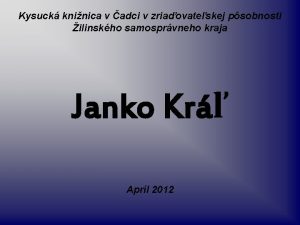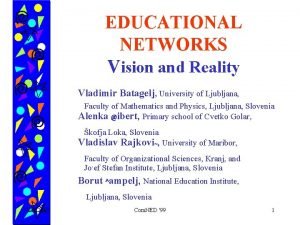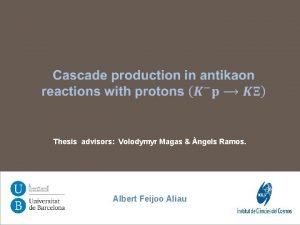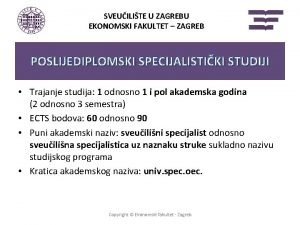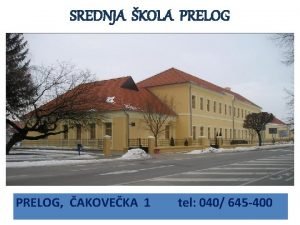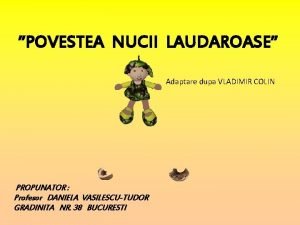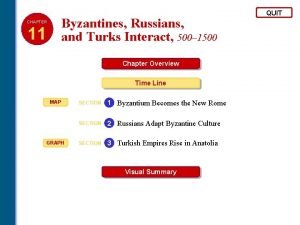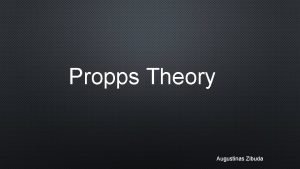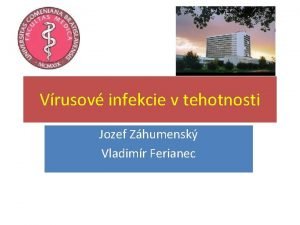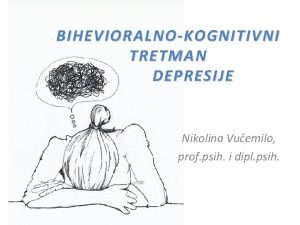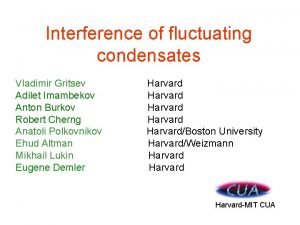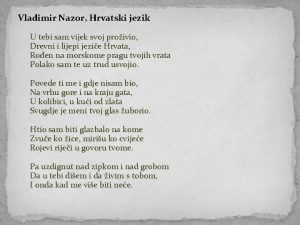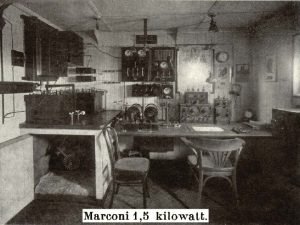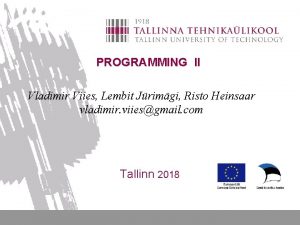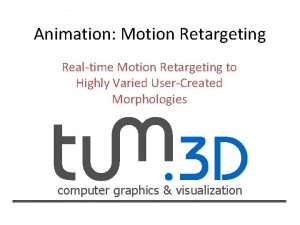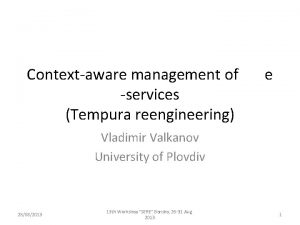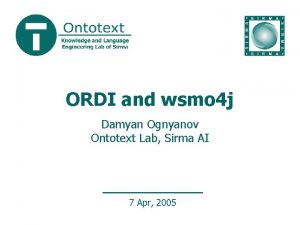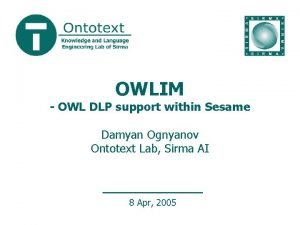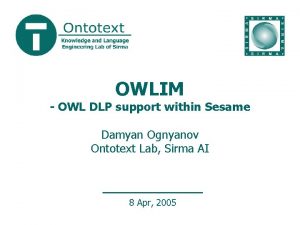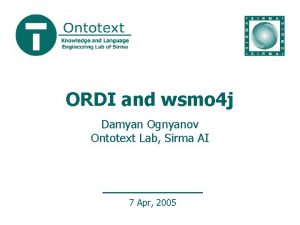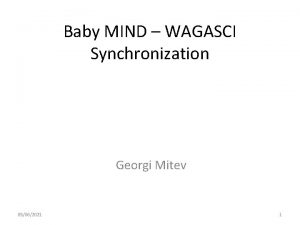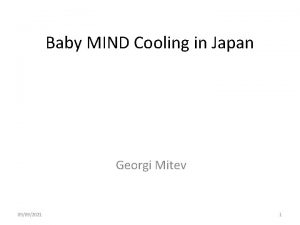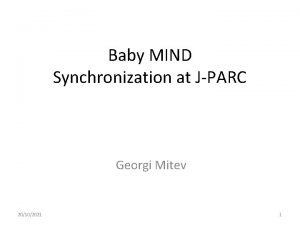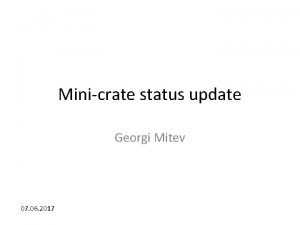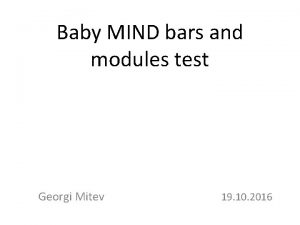Tempura Retargeting Damyan Mitev Vladimir Valkanov Plovdiv University




















- Slides: 20

Tempura Retargeting Damyan Mitev, Vladimir Valkanov Plovdiv University “Paisii Hilendarski” SEERE Workshop, Neum 2009 1

CAMe. LS project • flexible, adaptive, collaborative, context-aware service and agent-oriented e. Learning environment • uses Info. Station network architecture • delivers personalized, mobile, any-time and any -where assess to educational content and services SEERE Workshop, Neum 2009 2

Info. Station middleware • manages services and mobile users • scenario based – « No change » scenario – « Change IS » scenario – « Change MD » scenario – « Change both » scenario SEERE Workshop, Neum 2009 3

Scenarios • depend on movement of user and used mobile device • mandate different behavior of the middleware – different device profiles (capabilities) – cached information in the Info. Stations – availability of services in different Info. Stations • time dependant SEERE Workshop, Neum 2009 4

Scenario detection and control • we need – formal description of scenarios – mechanisms to interpret that description • we gain – flexible mechanisms for creating new (sub) scenarios – easily define corresponding middleware behavior SEERE Workshop, Neum 2009 5

Scenario formalism • Interval Temporal Logic – propositional and first-order logical reasoning – finite sequences – time intervals – capable of handling sequential and parallel composition • Tempura - executable ITL framework. SEERE Workshop, Neum 2009 6

Tempura usage • middleware – written in Java • Tempura – written in C – open source • possible usage of Tempura – wrapping existing Tempura executable with Java IO redirection – development of entirely new project, based on execution rules of ITL – reengineering of Tempura and rewriting it in Java SEERE Workshop, Neum 2009 7

Tempura retargeting • homogenous environment • usage of quality code as a basis • no steep curve learning ITL nuts and bolts SEERE Workshop, Neum 2009 8

Tempura source code diagram SEERE Workshop, Neum 2009 9

Retargeting plan • based on iterations • iteration phases – research phase – implementation phase – testing phase SEERE Workshop, Neum 2009 10

Plan for first iteration • research – understand Interval Temporal Logic • In progress – learn code structure, main program flow, structures and variables of Tempura interpreter • Mostly done – check possible usages of existing C-to Java conversion tools • No suitable software found – check possible usages of existing C analysis tools SEERE Workshop, Neum 2009 11

Plan for first iteration (cont’d) • implementation – create a Java class for every C source file and its associate header file – create a static method in the Java class for every function in the C file with the same name (ignoring Java naming conventions) – create static variable in the Java class for every global variable in the header file – create a static method in the Java class for every macro function in the header file (where appropriate) – expand the contents of every macro, not covered by the previous step – implement all struct and union types as Java classes – convert integer boolean assignments and expressions into proper Java boolean constructs – replace function pointers with instances of specially created Interface, SEERE Workshop, Neum 2009 12 which will call the desired Java method (delegates)

Plan for first iteration (cont’d) • implementation status (estimated) – 40 % of the source code – 80 % of the structures – 30 % of function pointers • problems – console oriented – scattered functions and variables – heavy use of c-specific syntax structures like macros, pointers, memory addressing, null terminated strings, inline initializers SEERE Workshop, Neum 2009 13

Plan for first iteration (cont’d) • testing – run the examples, which come with the original sources, on the Java interpreter and compare results • desired outcome – working JTempura interpreter by the end of the year SEERE Workshop, Neum 2009 14

Plan for second iteration • towards object-oriented structure – converting different Node types (denoted by their type member) into hierarchy of base class TNode and a descendant for every node type, supported by JTempura – converting various reducers from static members to Java classes and creating hierarchy of reducers with base class TReducer SEERE Workshop, Neum 2009 15

Plan for second iteration (cont’d) • towards object-oriented structure – redirecting input and output of the interpreter into streams – redesign memory management – redesign error handling and notification – group similar and relevant methods in one class – design complex objects for storing lexemes – implement syntax tree outcome of the parser, representing the given ITL expression SEERE Workshop, Neum 2009 16

Plan for second iteration (cont’d) • Object-oriented model for the second iteration SEERE Workshop, Neum 2009 17

Plan for third iteration • research – analyze different runtime verification (RV) tools and frameworks – learn different RV strategies – choose suitable strategy for our needs (service monitoring, scenario detection, Java) • implementation – towards runtime verification framework – implement at least one of the strategies SEERE Workshop, Neum 2009 18

Tools • Eclipse-CPP • Eclipse-Java • Power. Designer SEERE Workshop, Neum 2009 19

Thank you SEERE Workshop, Neum 2009 20
 Agentie retargeting
Agentie retargeting 沈榮麟
沈榮麟 Vladimír všeslav kráľ
Vladimír všeslav kráľ Lektira trojica u trnju kviz
Lektira trojica u trnju kviz Vladimir batagelj
Vladimir batagelj Vladimir olchanski
Vladimir olchanski Vladimir magas
Vladimir magas Vladimir davydenko
Vladimir davydenko Vlado leko
Vlado leko Vedrana bermanec
Vedrana bermanec Propunator
Propunator How did vladimir's conversion to christianity affect kiev
How did vladimir's conversion to christianity affect kiev Vladimir propp character theory
Vladimir propp character theory Vladimir gusev peintre
Vladimir gusev peintre Vladimir ferianec
Vladimir ferianec Vladimir cvijan
Vladimir cvijan Vladimir gritsev
Vladimir gritsev Kviz upravni i neupravni govor
Kviz upravni i neupravni govor Vladimir zworykin
Vladimir zworykin Halugica vladimir nazor
Halugica vladimir nazor Vladimir viies
Vladimir viies


